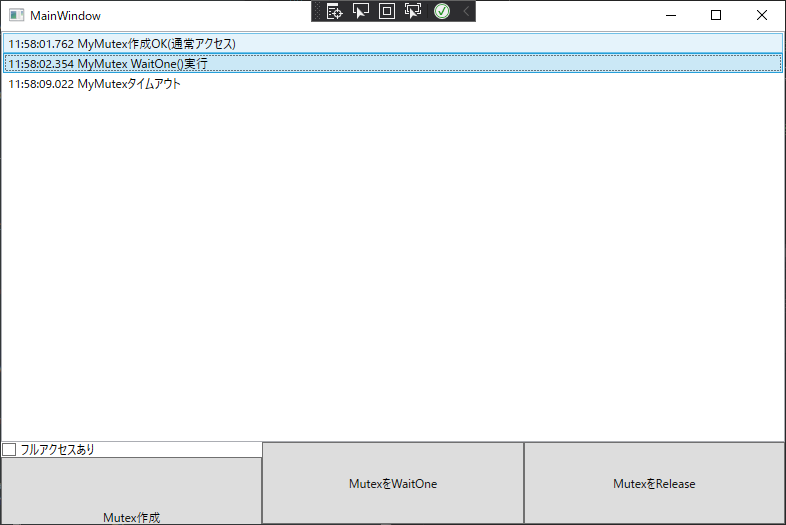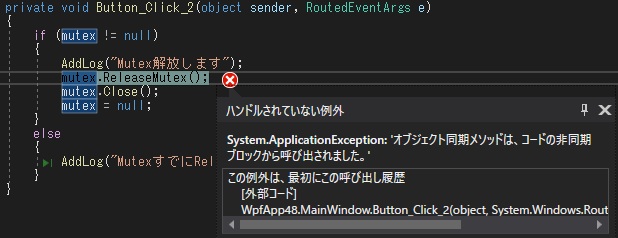mutex関連記事
やりたいこと
C#のアプリとC++のアプリの2つのアプリから一つのリソース(例えばファイル)に読み書きするときに、同時に読み書きしてしまうといろいろ都合が悪いので、同時にアクセスしないように排他制御をしたい。
やり方
Mutexを使う。基本的には、
- 別のアプリと同じ名前の名前付きMutexを作る。
- そのMutexを所有権を要求(WaitOne)して、
- 使える状態(シグナル状態)であれば、そのまま自分が所有して、使いたいリソースを使う。
- 他ですでに所有されている状態(非シグナル状態)であれば、他がmutex開放して使える状態になるまで待つ。
- 使いたいリソースを使い終わったら、所有していたmutexを開放(Release)する。
という流れでmutexを使う。
C#のサンプルコード
下記が、WPFでmutexを使うサンプルコード。別途C++版も作成して両方からmutexを使う実験をする。
<Window x:Class="WpfApp48.MainWindow"
xmlns="http://schemas.microsoft.com/winfx/2006/xaml/presentation"
xmlns:x="http://schemas.microsoft.com/winfx/2006/xaml"
xmlns:d="http://schemas.microsoft.com/expression/blend/2008"
xmlns:mc="http://schemas.openxmlformats.org/markup-compatibility/2006"
xmlns:local="clr-namespace:WpfApp48"
mc:Ignorable="d"
Title="MainWindow" Height="900" Width="800"
Loaded="Window_Loaded"
Name="root">
<Grid>
<Grid.RowDefinitions>
<RowDefinition Height="5*"/>
<RowDefinition Height="1*"/>
</Grid.RowDefinitions>
<Grid.ColumnDefinitions>
<ColumnDefinition />
<ColumnDefinition />
<ColumnDefinition />
</Grid.ColumnDefinitions>
<StackPanel Grid.Row="1" Grid.Column="0">
<CheckBox Name="cbSecurity" Content="フルアクセスあり"/>
<Button Content="Mutex作成" Click="Button_Click" Height="120"/>
</StackPanel>
<Button Grid.Row="1" Grid.Column="1" Content="MutexをWaitOne" Click="Button_Click_1"/>
<Button Grid.Row="1" Grid.Column="2" Content="MutexをRelease" Click="Button_Click_2"/>
<ListBox Grid.Row="0" Grid.Column="0" Grid.ColumnSpan="3"
ItemsSource="{Binding Logs, ElementName=root}"/>
</Grid>
</Window>
using System;
using System.Collections.ObjectModel;
using System.ComponentModel;
using System.Security.AccessControl;
using System.Security.Principal;
using System.Threading;
using System.Windows;
namespace WpfApp48
{
public partial class MainWindow : Window, INotifyPropertyChanged
{
#region INotifyPropertyChanged
public event PropertyChangedEventHandler PropertyChanged;
protected void OnPropertyChanged(string propertyName)=> this.PropertyChanged?.Invoke(this, new PropertyChangedEventArgs(propertyName));
#endregion
#region LogFramework
public ObservableCollection<string> Logs { get; set; } = new ObservableCollection<string>();
public void AddLog(string log)
{
DateTime now = DateTime.Now;
Logs.Add(now.ToString("hh:mm:ss.fff ") + log);
OnPropertyChanged(nameof(Logs));
}
#endregion
// Mutexの名前
// 「Global\\」をつけると、自分以外のUserとも共有できるMutexになる
// ただし、Create時に振るアクセスできるようにしておかないと、別Userが
// Create時にアクセス拒否例外になる
string mutexName = "Global\\MyMutex";
Mutex mutex;
public MainWindow() => InitializeComponent();
private void Window_Loaded(object sender, RoutedEventArgs e) { }
// Mutex作成
private void Button_Click(object sender, RoutedEventArgs e)
{
if (mutex == null)
{
try
{
if (cbSecurity.IsChecked != false)
{
var mutexSecurity = new MutexSecurity();
mutexSecurity.AddAccessRule(
new MutexAccessRule(
new SecurityIdentifier(WellKnownSidType.WorldSid, null),
MutexRights.Synchronize | MutexRights.Modify,
AccessControlType.Allow
)
);
mutex = new Mutex(false, mutexName, out _, mutexSecurity);
AddLog("MyMutex作成OK(フルアクセス)");
}
else
{
mutex = new Mutex(false, mutexName, out _, null);
AddLog("MyMutex作成OK(通常アクセス)");
}
}
catch (Exception ex)
{
AddLog(ex.Message);
}
}
else
{
AddLog("MyMutexすでに作成済み");
}
}
// チェック
private void Button_Click_1(object sender, RoutedEventArgs e)
{
bool signal = false;
if (mutex == null)
{
AddLog("MyMutex未作成");
return;
}
else
{
AddLog("MyMutex WaitOne()実行");
}
try
{
// mutexの所有権を要求する
// C++のCreateMutex()とOpenMutex()を一緒にやる感じ
signal = mutex.WaitOne(5000);
}
catch (AbandonedMutexException ex)
{
// 相手がmutexを解放する前に終了してしまった場合
signal = true;
AddLog(ex.Message);
}
if (signal)
{
AddLog("MyMutex作成完了");
}
else
{
AddLog("MyMutexタイムアウト");
mutex = null;
}
}
// 解放
private void Button_Click_2(object sender, RoutedEventArgs e)
{
if (mutex != null)
{
AddLog("Mutex解放します");
mutex.ReleaseMutex();
mutex.Close();
mutex = null;
}
else
{
AddLog("MutexすでにReleaseしてます");
}
}
}
}
実装・実験するうえで引っかかったこと
今回は、**「別々のユーザーで動いているC#とC++のアプリで、リソースを排他制御したい」**という要件があった。
(具体的には、C++はサービスとして動いていて、C#はGUIをもつWPFアプリとして動く。)
そういう条件でmutexを作ったときに困ったのが下記のような点。
普通の名前のmutexにすると、他のユーザーがすでにつけているmutexの名前と同じ名前のmutexを作る/所有する、ということができてしまう
つまり、そのままだと全然排他できてない、ということ。
(※同じユーザーが起動したものであれば、別のアプリであっても普通の名前で排他できていた)
対処方法としては、名前の前にGlobal\をつけて「グローバルミューテックスにする」ということ。
string mutexName = "Global\\MyMutex";
グローバルミューテックスにすれば、別のユーザーであっても同じ名前を付けていれば、排他制御に使える。
その次に引っかかったのが、
別のユーザーが作ったグローバルミューテックスと同じ名前のmutexを作ろうとすると、「アクセスが拒否されました」という例外になる
別ユーザーが作成したグローバルミューテックスは、そのままではアクセスできない様子。
対処方法としては、「グローバルミューテックスをフルアクセスできるようにして作成する」ということ。
var mutexSecurity = new MutexSecurity();
mutexSecurity.AddAccessRule(
new MutexAccessRule(
new SecurityIdentifier(WellKnownSidType.WorldSid, null),
MutexRights.Synchronize | MutexRights.Modify,
AccessControlType.Allow
)
);
mutex = new Mutex(false, mutexName, out _, mutexSecurity);
どのユーザーであってもアクセスできるようにしてやることで、グローバルミューテックスを通して複数ユーザーで排他できるようになった。
所有権を要求(WaitOne)をしてないのにReleaseすると例外になる
通常、mutexを作って所有権を要求(WaitOne)して、処理が終わったらRelease、という流れになるが、
mutexを作るだけ作ってWaitOneせずにReleaseしたら、下記のような例外になる。
非同期ブロックから呼び出すって何?と思うが、ともかくそういう例外になる。
対処としては、単純にWaitOneしてないものはReleaseしないようにする。
(これ起きるのはC#版だけかも?)
以上
上記を気にして作成すれば、C#版とC++版でmutexを通じて排他制御ができた。
参考
Mutexクラス(MSDocs)
https://docs.microsoft.com/ja-jp/dotnet/api/system.threading.mutex?view=net-5.0

